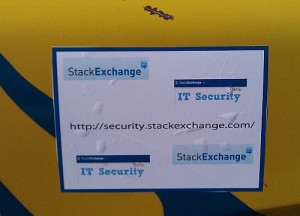One of my worst ever projects was implementing PGP email encryption. Considering I have only worked in large financial services companies, that is saying something. I have reflected on the lessons learnt from this project before, but I felt that PGP was fundamentally flawed. When Apple iOS 5 was unveiled, there was a small feature that no one talked about. It was hidden among the sparkling jewels of notifications, free messaging and just works synchronization. That feature was S/MIME email encryption support. Now S/MIME is not new, however Apple is uniquely positioned with their ecosystem and user-centric design to solve the fundamental problems and bring secure email to the masses.
I have detailed the problems that email encryption solves, and those it does not solve before. To re-iterate and update:
Attacker eavesdropping or modifying an email in transit. both on public networks such the Internet and unprotected wireless networks as well as private internal networks. Recently I have experienced things that have hammered home the reality of this threat: Heartfelt presentations at security conferences such as Uncon about the difficulties faced by those in oppressive regimes such as Iran, where the government reading your email could result in death or worse for you and your family. Even “liberal” governments such as the US blatantly ignoring the law to perform mass domestic wire tapping in the name of freedom. The right to privacy is a human right. Most critical communication these days is electronic. There is a clear problem to be solved in keeping this communication only to it’s intended participants.
Attacker reading or modifying emails in storage. The recent attacks on high profile targets such as Sony and low profile like MTGox, who were brought low by simple exploitation of unpatched systems and SQL injection vulnerabilities, have revealed an un-intended consequence. The email addresses and passwords published were often enough to allow attackers access to a users email account as the passwords were re-used. I don’t know about you but these days a lot of my most important information is stored in my gmail account. The awesome search capability, high storage capacity and accessibility everywhere means that it is a natural candidate for scanned documents and notes as well as the traditional highly personal and private communications. There is a problem to be solved of adding a layered defence; an additional wall in your castle if the front gate is breached.
Attacker is able to send emails impersonating you. It is amazing how much email is trusted today as being actually from the stated sender. In reality normal email provides very little non-repudiation. This means, it is trivial to send an email that appears to come from someone else. This is a major reason why phishing and spear phishing in particular are still so successful. Now spam blockers, especially good ones like Postini have become very good at examining email headers, verified sender domains, MX records etc to reject fraudulent emails (which is effective unless of course you are an RSA employee and dig it out of your quarantine). You can also have more localised proof of concept of this. If your work accepts manager e-mail approvals for things like pay rises and software access, and it also has open SMTP relays you can have some fun by Googling SMTP telnet commands. There is a problem to solve in how to reliably verify the sender of the email and ensure the contents have not been tampered with.
Problems not solved by email encryption and signing:
- Sending the wrong contents to the right person (s)
- Sending the right contents to the wrong person (s)
- Sending the wrong contents to the wrong person (s)
These are important to keep in mind because you need to choose the right tool for the job. Email encryption is not a panacea for all email mis-use cases.
So having established that there is a need for email encryption and signing, what are the fundemental problems with a market leading technology like PGP (now owned by Symantec)?
Fundemental problems in summary:
Key exchange. Bob Greenpeace wants to send an email to Alice Activist for the first time. He is worried about Evil Government and Greedy OilCorp reading it and killing them both. Bob needs Alice’s public key to be able to encrypt the document. If Bob and Alice both worked at the same company and had PGP universal configured correctly, or worked in organisations that both had PGP universal servers exposed externally, or had the foresight to publish their public keys to the public PGP global key server, all would be well. However this is rarely the case. Also email is a conversation. Alice not only wants to reply but also add in Karl Boatdriver in planning the operation. Now suddenly all three need his public keys and he theirs. Bob, Alice and Karl are all experts in their field but not technical and have no idea how to export and send their public keys and install these keys before sending secure email. They have an operation to plan for Thursday!
Working transparently and reliably everywhere. Bob is also running Outlook on his Windows phone 7 (chuckles), Alice Pegasus on Ubuntu and Karl Gmail via Safari on his iPad. Email encryption, decryption, signing, signature verification, key exchange all need to just work on all of these and more. It also cannot be like PGP desktop which uses a dirty hack to hook into a rich email client. This gives it extremely good reliability and performance. Intermittent issues like emails going missing and blank emails never occur. Calls to PGP support for any enterprise installation are few and far between. All users in companies love PGP and barely notice it is there. In many organisations email is the highest tier application. It has to have three nines uptime. If Alice and Karl are about to be captured by Greedy Oilcorp and they need to get an email to Bob they cannot afford to get a message blocked by PGP error.
Less fundamental but still annoying:
- Adding storage encryption – there is no simple way with PGP to encrypt a clear text email in storage. You can send it to yourself again or export it to a file system and encrypt it there but that is it. This is a problem in where the email is not sensitive enough to encrypt in transit (or just where you just forgot) but where after the fact, you do care if script kiddies with your email password get that email and publish it on Pastebin.
How Apple could solve these fundamental problems with iOS 5
Key exchange – If you read marknca‘s excellent iOS security guide, you will see that Apple has effectively built a Public Key Infrastructure (PKI). Cryptographically signing things like apps and checking this signature before allowing them to run is key to their security model. This could be extended to users to provide email encryption and specifically transparent key exchange in the following manner:
- Each user with an Apple ID would have a public/private key pair automatically generated
- The public keys would be stored on the Apple servers and available via API and on the web to anyone
- The private keys would be encrypted to the the users Apple account passphrase and be synchronised via iCloud to all iOS and Mac endpoints
- To send a secure email the user would just click a secure button on their email tool
- When sending an email via an iOS device, a Mac or via Mobile me web it would query the Apple servers for the recipients private key and encrypt and sign (optional) the email
- On receipt as long as the device had been unlocked the email would be decrypted. For web access as long as the certificate was stored in the browser the email would be decrypted (could be an addon to Safari)
- To encrypt an email in storage you would just drag it to a folder called private email. You could write rules for what emails were automatically stored there.
This system would make key exchange, email encryption, decryption and signing totally transparent. Because S/MIME uses certificates it is easy to get the works everywhere property. However Apple would first enable this only for .me addresses and iOS devices and Mac’s to enable them to sell more of these and to beef up their enterprise cred. Smart hackers and addon writers would soon make it work everywhere though. There you go, secure email for the masses.
Tagged: Email, Encryption, Mobile







